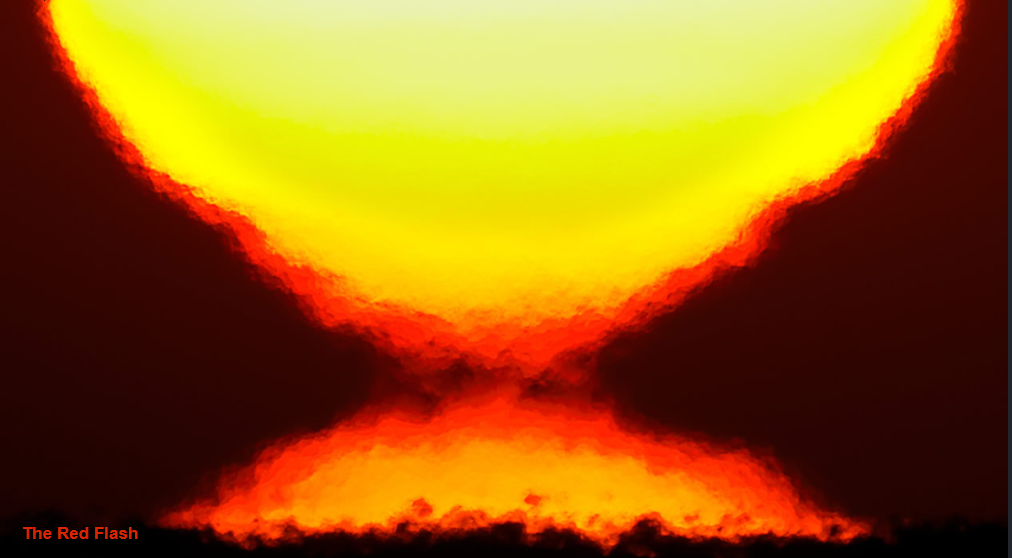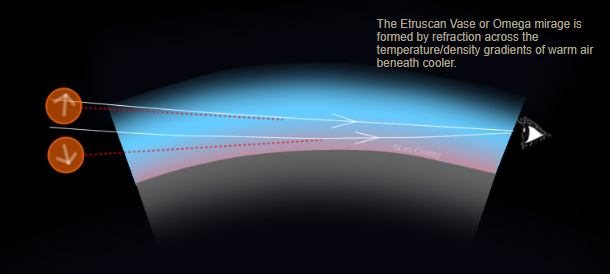OPOD - Red Flash - Etruscan Vase Mirage
OPOD - Red Flash - Etruscan Vase Mirage: Exploring the Phenomenon
Have you ever witnessed a mesmerizing optical phenomenon during a sunset or sunrise? One such captivating sight is the Etruscan Vase Mirage, also known as the Omega Mirage, which creates the illusion of two suns in the sky. In this article, we will delve deeper into the intricacies of this atmospheric optics phenomenon and understand the science behind it.
The Red Flash: A Spectacular Sight
In Buenos Aires, Argentina, photographer Luis Argerich captured an image that showcases the Red Flash phenomenon. As the sun rises, it is miraged into a classical 'Etruscan Vase' or 'Omega' shape. What makes this sight truly captivating is the vivid red color at the junction of the two sun images, known as the red flash. This red flash is the exact counterpart of the subsequent green flash that occurs during sunset.
The Mechanics of the Etruscan Vase Mirage
The Etruscan Vase Mirage occurs due to refraction across temperature and density gradients in the atmosphere. As warm air lies beneath cooler air, sunlight passing through these varying air masses gets refracted, resulting in the formation of an upper erect image and a lower inverted image of the sun. During a sunset, the lower image rises while the upper one sinks.
Unveiling the Fold Line
Fascinating things happen at the fold line, which is where the two sun images meet. At this point, the images are stretched vertically, causing their colors to separate and become visible. As the two red rims converge at the fold line, a remarkable sight unfolds - the red flash. Similarly, during sunset, when the green rims merge, a green flash is observed.
Vertical Magnification: The Key to the Green Flash
The fold line plays a crucial role in the occurrence of the green flash. This location experiences high vertical magnification, which leads to maximum color dispersion. As the sunset progresses, the two images of the sun's upper limb slide together, with the top image sinking and the bottom inverted image rising. The mirage magnifies the upper limb's rim vertically, resulting in a vivid green flash.
The Red Flash: An Early Sunset Phenomenon
During the earlier stages of a sunset, when the two images of the sun's lower limb meet at the fold line, an enhanced vertical color dispersion gives rise to a red flash. This mesmerizing sight occurs as the images distort and then join, as though attracted and glued together.
The Location of the Flashes
Both the green and red flashes occur slightly above the horizon. It is important to exercise caution when searching for these phenomena. Never use binoculars and avoid direct, prolonged staring at the sun. Protect your eyes and cherish these rare optical spectacles.
In conclusion, the Etruscan Vase Mirage, with its red and green flashes, offers a captivating visual experience during sunsets and sunrises. Understanding the science behind this atmospheric optics phenomenon allows us to appreciate the beauty and complexity of nature's artistic display. So, keep your eyes peeled for these enchanting flashes and treasure the wonders that unfold in the sky above us.

The Red Flash
An image from Buenos Aires, Argentina by Luis Argerich (photography). The rising sun is miraged into a classical 'Etruscan Vase' or 'Omega' shape. The junction of the two sun images (one rising the other descending) is a vivid red - a red flash, the exact counterpart of the subsequent green flash. ©Luis Argerich, shown with permission.
Above the fold line is an erect sun with a thin and normally invisible green upper limb and lower red one. Below the fold the second image is inverted with its top edge red and lower one green. Images are stretched vertically at the fold and their colours separate to become visible. As the two red rims meet at the fold we see a red flash.. ..and a green flash when the green rims merge.


The Etruscan Vase or Omega mirage is formed by refraction across the temperature/density gradients of warm air beneath cooler.
Etruscan Vase sunsets and sunrises are mirages of two suns. Let�s talk here only of sunsets � sunrises are the same but with opposite vertical movements. Warm air beneath cooler refracts sunlight to give an upper erect image and a lower inverted image. During a sunset the lower image rises as the upper one sinks.
Interesting things happen where the two images meet. This is at the �fold line�.. At the fold the images are stretched vertically. We can see that as the sunset progresses � the two images are liquid-like in that they distort and then join as though attracted and glued.
The high vertical magnification at the fold is the key to the green flash. This is the place of maximum colour dispersion. At the final phase of the sunset, the two images of the sun�s upper limb slide together � the top image sinking and the bottom inverted one rising. Colour dispersion gives the upper limb a slight green rim and as the two images merge the thin green line is all there is. The mirage magnifies the rim vertically � enough to flash out a vivid green.
And earlier in a sunset when the two � red edged - images of the sun�s lower limb meet at the fold? The enhanced vertical colour dispersion then gives a red flash.
The fold line is slightly above the horizon as are the green and red flashes.
Take extreme care when searching for green and particularly red flashes. Never use binoculars and never stare at the sun. Treasure eyes.
Note: this article has been automatically converted from the old site and may not appear as intended. You can find the original article here.
Reference Atmospheric Optics
If you use any of the definitions, information, or data presented on Atmospheric Optics, please copy the link or reference below to properly credit us as the reference source. Thank you!
-
<a href="https://atoptics.co.uk/blog/opod-red-flash-etruscan-vase-mirage/">OPOD - Red Flash - Etruscan Vase Mirage</a>
-
"OPOD - Red Flash - Etruscan Vase Mirage". Atmospheric Optics. Accessed on December 21, 2024. https://atoptics.co.uk/blog/opod-red-flash-etruscan-vase-mirage/.
-
"OPOD - Red Flash - Etruscan Vase Mirage". Atmospheric Optics, https://atoptics.co.uk/blog/opod-red-flash-etruscan-vase-mirage/. Accessed 21 December, 2024
-
OPOD - Red Flash - Etruscan Vase Mirage. Atmospheric Optics. Retrieved from https://atoptics.co.uk/blog/opod-red-flash-etruscan-vase-mirage/.